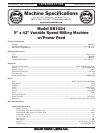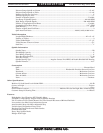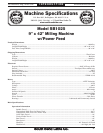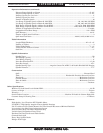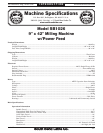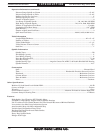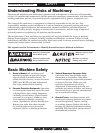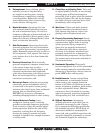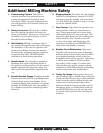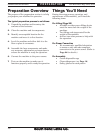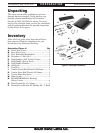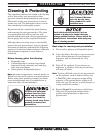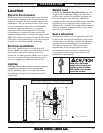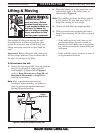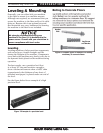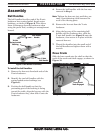
For Machines Mfg. Since 8/09 SB1024/SB1025/SB1026
-15-
SAFETY
Additional Milling Machine Safety
6. Stopping Spindle: To reduce the risk of hand
injuries or entanglement hazards, DO NOT
attempt to stop the spindle with your hand
or a tool. Allow the spindle to stop on its own
or use the spindle brake.
7. Chip Cleanup:
Chips from the operation are
sharp and hot, which can cause burns or
cuts. Using compressed air to clear chips
could cause them to fly into your eyes, and
may drive them deep into the working parts
of the machine. Use a brush or vacuum
to clear away chips and debris from the
machine or workpiece and NEVER clear
chips while the spindle is turning.
8. Machine Care & Maintenance:
Operating
the mill with excessively worn or damaged
machine parts increases the risk of machine
or workpiece breakage which could eject
hazardous debris at the operator. Operating
a mill in poor condition will also reduce
the quality of the results. To reduce this
risk, maintain the mill in proper working
condition by ALWAYS promptly performing
routine inspections and maintenance.
9. Cutting Tool Usage:
Cutting tools have very
sharp leading edges—handle them with care!
Using cutting tools that are in good condition
helps to ensure quality milling results and
reduces the risk of personal injury from
broken tool debris. Inspect cutting tools for
sharpness, chips, or cracks before each use,
and ALWAYS make sure the cutting tools
are firmly held in place before starting the
machine.
1. Understanding Controls:
The mill is a
complex machine that presents severe
cutting or amputation hazards if used
incorrectly. Make sure you understand the
use and operation of all controls before you
begin milling.
2. Safety Accessories:
Flying chips or debris
from the cutting operation can cause eye
injury or blindness.
Always use a chip guard
in addition to your safety glasses or use a
face shield when milling.
3. Work Holding:
Milling a workpiece that is
not properly clamped to the table could cause
the workpiece to fly into the operator with
deadly force! Before starting the machine,
be certain the workpiece has been properly
clamped to the table. NEVER hold the
workpiece by hand during operation.
4. Spindle Speed:
To avoid tool or workpiece
breakage that could send flying debris at
the operator and bystanders, use the correct
spindle speed for the operation. Allow the
mill to gain full speed before beginning the
cut.
5. Spindle Direction Change:
Changing spindle
rotation direction while it is spinning could
lead to impact injury from broken tool or
workpiece debris, and workpiece or machine
damage. ALWAYS make sure the spindle is
at a complete stop before changing spindle
direction.



